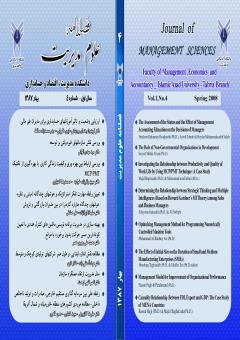Optimizing Management Method for Programming Numerically Controlled Mashine Tools
Subject Areas : Business Management
1 - Assistant Professor, Faculty of Science, Tabriz Branch, Islamic Azad University, Tabriz, Iran
Keywords: Segments, Minimum Route, Short Path Algorithm, Globally Supporting Lines, Boundary Lines, Collision Avoidance, C.N.C Machine Tool Program Optimization,
Abstract :
This paper presents an algorithmic approach to solve the problem of excessive travel in C.N.C. machine tools by introducing an efficient management method to compute the shortest path between the given sets of points (origin and destination) in R2 (x, y) plane. When a work piece is located (as an obstacle) between sets of points, it is proved that the optimum path between these points would be formed by sequences of connected straight line segments whose intermediate end points are vertices of an appropriate polygonal (closed control barrier). The case of one origin, one destination, and a set of barriers is considered in this research. This method is computationally efficient.
Kirk, D., & LIM, L. (2006). A dual-mode routing algorithm for an autonomous roving vehicle. IEEE Transactions on Aerospace and Electronic Systems, 6, 290-294.
Toh, C. K. (2008). Cutter path strategies in high speed machining of hardened steel,Materials & Design. Article in Press,
Shkel, A. M., & Lumelsky, V. (2001). Robotics abd autonomous systemd classification of the Dubins set 1. Robotics and Autonomous Systems, 34(4), 179-202.
Vaccaro, H. (1994). Alternative techniques for modeling travel distance. MA. Thesis in Civil Engineering. Massachusetts Institute of Technology.
Wang dahl, G., Pollock, S., & Woodward, J. (1994). Minimum trajectory pipe routing. Journal of Ship Research, 18, 46-49.
Larson, R., & Li, G. (1983). Facility locations with the Manhattan metric the presence of barriers to travel. Operations Research, 31, 652-669.
Viegas, J. (1999). Capacity expansion in public facility networks. Phd Thesis, Lisbon: Institute Superior Tecnico.
_||_Kirk, D., & LIM, L. (2006). A dual-mode routing algorithm for an autonomous roving vehicle. IEEE Transactions on Aerospace and Electronic Systems, 6, 290-294.
Toh, C. K. (2008). Cutter path strategies in high speed machining of hardened steel,Materials & Design. Article in Press,
Shkel, A. M., & Lumelsky, V. (2001). Robotics abd autonomous systemd classification of the Dubins set 1. Robotics and Autonomous Systems, 34(4), 179-202.
Vaccaro, H. (1994). Alternative techniques for modeling travel distance. MA. Thesis in Civil Engineering. Massachusetts Institute of Technology.
Wang dahl, G., Pollock, S., & Woodward, J. (1994). Minimum trajectory pipe routing. Journal of Ship Research, 18, 46-49.
Larson, R., & Li, G. (1983). Facility locations with the Manhattan metric the presence of barriers to travel. Operations Research, 31, 652-669.
Viegas, J. (1999). Capacity expansion in public facility networks. Phd Thesis, Lisbon: Institute Superior Tecnico.


